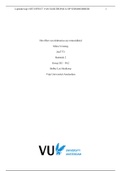STATISTICS SUMMARY
The Big Picture Summary of
Statistics
Some basic math:
- Two negatives make a positive: −2 × −4 = 8
- A negative number multiplied by a positive one make a negative number: 2 × −4 = −8
- BODMAS
o This is an acronym for the order in which mathematical operations are performed. It
stands for Brackets, Order, Division, Multiplication, Addition, Subtraction and this is
the order in which you should carry out operations within an equation.
~1~
,STATISTICS SUMMARY
~2~
,STATISTICS SUMMARY
Table of Contents
1 The Very Basics...................................................................................................................................6
1.1 Independent and Dependent Variables.......................................................................................6
1.2 Levels of Measurements..............................................................................................................6
1.3 Analyzing Data.............................................................................................................................6
1.3.1 Frequency distributions........................................................................................................6
1.3.2 Center of Distribution...........................................................................................................8
1.3.3 Dispersion in a distribution...................................................................................................8
1.3.4 Probability.............................................................................................................................8
1.3.5 Fitting statistical models to the data.....................................................................................8
2 Statistical Models................................................................................................................................9
2.1 Linear Models..............................................................................................................................9
2.2 The Mean as Statistical Model.....................................................................................................9
2.3 Standard Error...........................................................................................................................11
2.4 Confidence Intervals..................................................................................................................11
2.5 Test statistics.............................................................................................................................12
2.6 One- and two-tailed tests..........................................................................................................12
2.7 Type 1 and Type 2 error.............................................................................................................13
2.8 Effect Sizes.................................................................................................................................13
2.9 Statistical power........................................................................................................................14
3 Exploring data with graphs...............................................................................................................14
3.1 Graphing Relationships: Scatterplot...........................................................................................14
3.2 Histograms.................................................................................................................................14
3.3 Boxplots.....................................................................................................................................14
3.4 Check for Outliers......................................................................................................................15
3.5 Density Plots..............................................................................................................................15
4 Exploring Assumptions......................................................................................................................15
4.1 Assumptions of parametric data................................................................................................16
4.2 The Assumption of Normality....................................................................................................16
4.3 Testing homogeneity of Variance..............................................................................................17
4.4 Correcting Problems in the Data................................................................................................18
5 Correlation........................................................................................................................................18
5.1 How do we measure relationships?...........................................................................................18
5.2 Standardization and the correlation coefficient.........................................................................19
~3~
, STATISTICS SUMMARY
5.3 Spearman’s correlation coefficient............................................................................................20
5.4 Partial and semi-partial correlation...........................................................................................20
6 Regression........................................................................................................................................20
6.1 Method of least squares............................................................................................................21
6.2 Assessing the goodness of fit.....................................................................................................22
6.3 Assessing individual predictors..................................................................................................24
6.4 Simple Regression Summary......................................................................................................24
6.5 Multiple Regression...................................................................................................................25
6.6 Methods of Regression..............................................................................................................25
6.7 Accuracy of Regression model...................................................................................................25
6.8 Categorical Regression and multiple regression........................................................................27
7 Comparing two means......................................................................................................................27
7.1 The T-Test..................................................................................................................................27
7.1.1 Rationale.............................................................................................................................28
7.1.2 Assumptions........................................................................................................................28
7.2 Independent T-Test....................................................................................................................28
7.3 Dependent T-Test......................................................................................................................30
8 One-way ANOVA...............................................................................................................................31
8.1 Inflated error rates.....................................................................................................................31
8.2 Interpreting F.............................................................................................................................31
8.3 ANOVA as regression.................................................................................................................32
8.4 Logic of the F-Ratio....................................................................................................................34
8.5 Total Sum of Squares.................................................................................................................35
8.6 Model Sum of Squares...............................................................................................................35
8.7 Residual Sum of Squares............................................................................................................36
8.8 Mean Squares............................................................................................................................37
8.9 The F-Ratio.................................................................................................................................37
8.10 Assumptions of ANOVA...........................................................................................................38
8.11 What’s after ANOVA?...............................................................................................................38
8.11.1 Planned contrasts.............................................................................................................39
8.11.2 Post-Hoc Procedures.........................................................................................................41
9 Analysis of Covariance (ANCOVA).....................................................................................................43
9.1 Assumptions..............................................................................................................................43
9.2 General Procedure for ANCOVA................................................................................................44
9.3 Calculating the effect size..........................................................................................................46
10 Two-way ANOVA.............................................................................................................................46
~4~
The Big Picture Summary of
Statistics
Some basic math:
- Two negatives make a positive: −2 × −4 = 8
- A negative number multiplied by a positive one make a negative number: 2 × −4 = −8
- BODMAS
o This is an acronym for the order in which mathematical operations are performed. It
stands for Brackets, Order, Division, Multiplication, Addition, Subtraction and this is
the order in which you should carry out operations within an equation.
~1~
,STATISTICS SUMMARY
~2~
,STATISTICS SUMMARY
Table of Contents
1 The Very Basics...................................................................................................................................6
1.1 Independent and Dependent Variables.......................................................................................6
1.2 Levels of Measurements..............................................................................................................6
1.3 Analyzing Data.............................................................................................................................6
1.3.1 Frequency distributions........................................................................................................6
1.3.2 Center of Distribution...........................................................................................................8
1.3.3 Dispersion in a distribution...................................................................................................8
1.3.4 Probability.............................................................................................................................8
1.3.5 Fitting statistical models to the data.....................................................................................8
2 Statistical Models................................................................................................................................9
2.1 Linear Models..............................................................................................................................9
2.2 The Mean as Statistical Model.....................................................................................................9
2.3 Standard Error...........................................................................................................................11
2.4 Confidence Intervals..................................................................................................................11
2.5 Test statistics.............................................................................................................................12
2.6 One- and two-tailed tests..........................................................................................................12
2.7 Type 1 and Type 2 error.............................................................................................................13
2.8 Effect Sizes.................................................................................................................................13
2.9 Statistical power........................................................................................................................14
3 Exploring data with graphs...............................................................................................................14
3.1 Graphing Relationships: Scatterplot...........................................................................................14
3.2 Histograms.................................................................................................................................14
3.3 Boxplots.....................................................................................................................................14
3.4 Check for Outliers......................................................................................................................15
3.5 Density Plots..............................................................................................................................15
4 Exploring Assumptions......................................................................................................................15
4.1 Assumptions of parametric data................................................................................................16
4.2 The Assumption of Normality....................................................................................................16
4.3 Testing homogeneity of Variance..............................................................................................17
4.4 Correcting Problems in the Data................................................................................................18
5 Correlation........................................................................................................................................18
5.1 How do we measure relationships?...........................................................................................18
5.2 Standardization and the correlation coefficient.........................................................................19
~3~
, STATISTICS SUMMARY
5.3 Spearman’s correlation coefficient............................................................................................20
5.4 Partial and semi-partial correlation...........................................................................................20
6 Regression........................................................................................................................................20
6.1 Method of least squares............................................................................................................21
6.2 Assessing the goodness of fit.....................................................................................................22
6.3 Assessing individual predictors..................................................................................................24
6.4 Simple Regression Summary......................................................................................................24
6.5 Multiple Regression...................................................................................................................25
6.6 Methods of Regression..............................................................................................................25
6.7 Accuracy of Regression model...................................................................................................25
6.8 Categorical Regression and multiple regression........................................................................27
7 Comparing two means......................................................................................................................27
7.1 The T-Test..................................................................................................................................27
7.1.1 Rationale.............................................................................................................................28
7.1.2 Assumptions........................................................................................................................28
7.2 Independent T-Test....................................................................................................................28
7.3 Dependent T-Test......................................................................................................................30
8 One-way ANOVA...............................................................................................................................31
8.1 Inflated error rates.....................................................................................................................31
8.2 Interpreting F.............................................................................................................................31
8.3 ANOVA as regression.................................................................................................................32
8.4 Logic of the F-Ratio....................................................................................................................34
8.5 Total Sum of Squares.................................................................................................................35
8.6 Model Sum of Squares...............................................................................................................35
8.7 Residual Sum of Squares............................................................................................................36
8.8 Mean Squares............................................................................................................................37
8.9 The F-Ratio.................................................................................................................................37
8.10 Assumptions of ANOVA...........................................................................................................38
8.11 What’s after ANOVA?...............................................................................................................38
8.11.1 Planned contrasts.............................................................................................................39
8.11.2 Post-Hoc Procedures.........................................................................................................41
9 Analysis of Covariance (ANCOVA).....................................................................................................43
9.1 Assumptions..............................................................................................................................43
9.2 General Procedure for ANCOVA................................................................................................44
9.3 Calculating the effect size..........................................................................................................46
10 Two-way ANOVA.............................................................................................................................46
~4~










